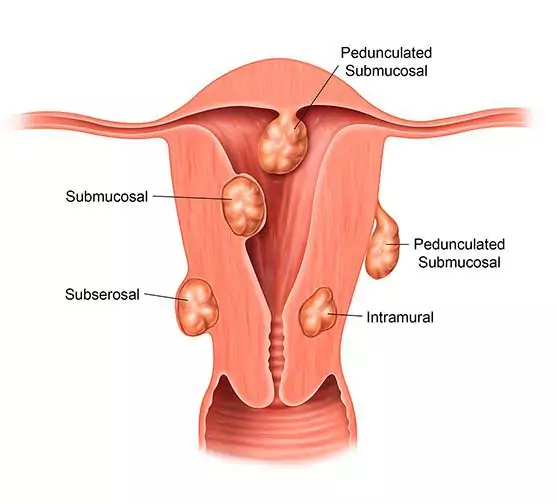Fibroids vs. Cysts
Ovarian cysts and uterine fibroids are both common conditions of the female reproductive tract. There is some overlap in physical symptoms, but ovarian cysts and fibroids are separate medical issues—with different causes, complications, and treatments. Here’s what you need to know about fibroids vs. cysts in order to understand the differences between the two.
What’s the difference between cysts and fibroids?
Uterine Fibroids (Fibroids Cysts in the Uterus)
Fibroids are firm, dense, non-cancerous tumors made of smooth muscle and fibrous connective tissue. They can also develop either singly or in clusters. Fibroids grow inside the uterine cavity, inside the uterine wall, or on the outside surface of the uterus, and they can vary in size.

There are four main types of fibroids:
- Intramural fibroids develop within the uterine wall. This can lead to an enlarged uterus if it grows from the wall into the uterine cavity. Intramural fibroids can cause heavy, prolonged periods, bleeding between cycles, and a protruding abdomen.
- Submucosal fibroids may form under the uterine lining within the cavity. They do not always cause noticeable symptoms but can interfere with fertility.
- Subserosal fibroids develop on the outer wall of the uterus and can put pressure on surrounding organs. Subserosal fibroids tend not to cause heavy bleeding but can result in severe pelvic pain.
- Pedunculated fibroids grow on stalks inside the uterine cavity and can cause intense pelvic pain and cramps.
Ovarian cysts
Ovarian cysts are fluid-filled sacs that can grow on the inside or outside of the ovary. They can grow singly or in clusters and don’t usually cause severe discomfort. They may even go away on their own.
The two most common types of ovarian cysts are:
- Follicle cysts: These develop when the follicle of the ovary fails to rupture and release an egg that would normally be released.
- Corpus luteum cysts: This occurs when the corpus luteum (what forms when a follicle seals itself off after releasing an egg) fills with fluid, which causes a buildup.

Fibroids vs. PCOS
Fibroids and PCOS can usually both be detected during a standard pelvic exam. If either is suspected, your doctor will likely order an ultrasound to confirm the diagnosis. If you have a solid cyst, your doctor will most likely order a blood test to determine if it is cancerous or benign. Fibroids may also be diagnosed using magnetic resonance imaging (MRI).
What symptoms are the same?
Women with fibroids and ovarian cysts may experience some of the same symptoms, such as:
- Pelvic pain or pressure
- Abdominal pain or pressure
- Abdominal bloating or protruding belly
- Pain or soreness in the lower back and thighs
- Difficulty urinating
- Frequent urination
- Pain during sex
- Unexplained weight gain
- Pain during your period
- Breast tenderness
- Constipation or other bowel issues
What symptoms are different?

Additional symptoms of fibroids may include:
- Heavy, prolonged periods (lasting more than 10 days in a month)
- Bleeding between menstrual cycles
- Anemia and fatigue from blood loss
Additional symptoms of ovarian cysts may include:
- Ovarian torsion, where the ovary is twisted and displaced
- Ovarian rupture, which is usually indicated by sudden, intense pain in the pelvis or abdomen (often on one side), accompanied by fever and/or vomiting
Causes and treatments: Fibroids vs. cysts
Every month, your ovaries develop cysts when an egg is released and hormones are produced. These cysts usually go away on their own.
If treatment becomes necessary, a surgeon can remove the cyst through:
- Laparoscopy, in which the cyst is removed through small incisions in the abdomen
- Oophorectomy, in which the entire ovary is removed
The precise causes of fibroids are not yet known, but there is evidence that genetics, hormones, and other growth factors in combination play a part. Some risk factors include of Black racial group; diet and nutritional deficiencies; and other medical conditions, such as obesity and hypertension.
Treatment options for fibroids include:
- Medications, such as birth control pills and other hormone manipulators
- Non-invasive procedures, such as uterine fibroid embolization (UFE) and focused ultrasound surgery
- Surgeries, such as myomectomy and hysterectomy allowing fibroids to be surgically removed


